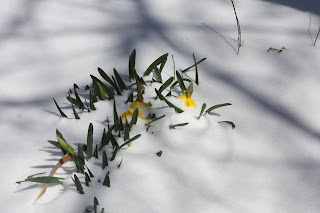De-icing Salts Can Kill Plants
 Snow and ice on our driveways, sidewalks and streets are safety hazards and salt is one of the primary treatments. Unfortunately, heavy applications of salt cause problems for waterways, wildlife and plants. There are better ideas for the health of your driveway, pets and landscape.
Snow and ice on our driveways, sidewalks and streets are safety hazards and salt is one of the primary treatments. Unfortunately, heavy applications of salt cause problems for waterways, wildlife and plants. There are better ideas for the health of your driveway, pets and landscape.
Deicing salt is so strong that it can degrade concrete, stone and metal. Each teaspoon of salt applied can pollute 5 gallons of ground and stream water, killing fish, insects and amphibians. Salty water around landscape plants is absorbed by their roots, dehydrating and burning the plants.
Use push and scoop shovels to remove and scrape snow off surfaces. Then, sweep away as much snow as you can so ice does not form and then let the rest melt.
If deicing salt is necessary, remove the snow first and use as little salt as possible, applying it on critical paths. Spread it sparingly and evenly with about 3-inches between salt grains.
A 12 ounce coffee mug of salt is enough to treat ice on a 20-foot driveway, according to research at the University of Minnesota.
If you use salt often, plant trees and shrubs at least 3 feet from the area usually salted and if you live on a street that is regularly treated, place them 7 feet from the road. Avoid getting salt in ditches, ponds or on lawns.
Some trees are tolerant of normal amounts of deicing salt, including: Austrian pine, ginkgo, buckeye, white poplar, black walnut, locust and red oak.
The University of Minnesota created a 15-minute video about the impact of salt on watersheds and how to effectively deice driveways and sidewalks (https://bit.ly/1FG4aF8).
Instead of salt, use sand to provide traction. If chemicals are necessary, magnesium and calcium chloride work best but both will irritate your pets’ feet.
On an average 150-square foot parking space will need ½ pound of deicer so 4-pounds of deicer will treat 1,000 square feet. Store unused deicer in a covered container so it remains usable.



Comments